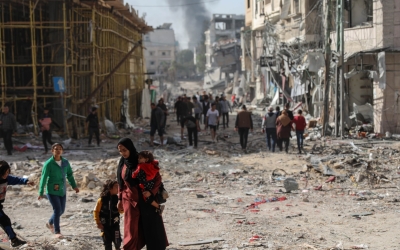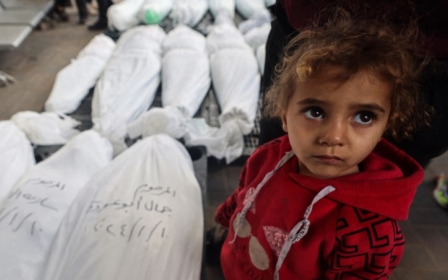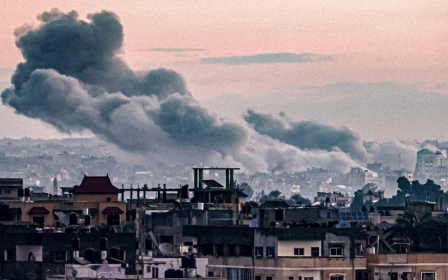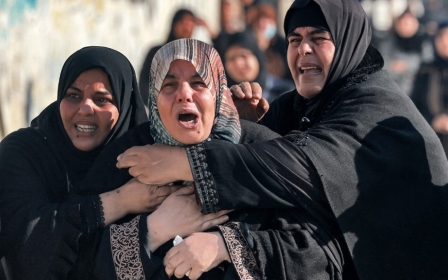In Gaza, you don’t only see death. You smell it. You breathe it

I never imagined in my wildest nightmares that I would be chasing after a stray dog to retrieve a tiny baby’s leg from its mouth.
Over the past three weeks, Israeli forces have been mercilessly bombing my neighbourhood of Rimal in northern Gaza, resulting in the massive destruction of residential buildings along al-Galaa Street.
Many of my neighbours’ homes that were targeted were inhabited and packed with people who had fled other areas under bombardment to shelter with relatives.
I was among a group of young men who took upon themselves the arduous mission of rescue and retrieval. We did our best to dig survivors from under huge piles of rubble and attempted to remove the bodies of the dead to give them a proper burial.
We were surrounded by Israeli snipers, however, who shot at anyone who approached the rubble, killing five men. After that, the search mission was halted.
But soon, faint voices came from under the rubble. It was the pleas of two toddlers and their desperate mother. Despite our attempts, we were unable to reach the trapped children, who eventually died under the rubble.
We then tried to dig out their mother, who was devastated and injured, to allow her to breathe and to give her water, somehow, to drink and a few dates to eat so she could stay alive.
Throughout that whole ordeal, Israeli forces and their heavy armoured vehicles and machines were hovering around us, besieging us and denying us access to the wounded and trapped while preventing us from leaving the area. We were forced to seek shelter in one of the neighbours’ houses.
‘Rotting corpses’
Following massive air strikes and the flattening of our neighbourhood, Israeli forces launched a brutal invasion, storming the few standing homes, targeting and arresting many youth, and committing public executions of displaced people seeking safe passage to escape the bombings.
I never thought that I would be chasing dogs who were eating the bodies of my neighbours and their children
The group I was with fled to the beach area and returned a few days later.
I first went to check on the mother, who was still buried under the rubble. I called her name and crawled beneath the concrete walls, but there was only silence.
We dug further only to find that she had passed away with her arms wrapped around the tiny bodies of her children.
Some days after returning to our neighbourhood, we noticed that a pack of stray dogs had come and taken shelter in one of the bombed-out houses next to us. Throughout the night, we heard them barking and howling loudly, as though they were fighting over something.
Follow Middle East Eye's live coverage of the Israel-Palestine war
In the light of morning, I found the pack of dogs. I was startled to see that one of them had the foot of a small child in his mouth. I chased after him, removed the little boy’s foot and buried it deep in the ground.
I never thought that I would be chasing dogs that were eating the bodies of my neighbours and their children.
On the following day, we found the remains of a child’s spine, bones and chest being eaten by the dogs. I had never seen anything more brutal or shameful, as though there was no value for human life. It was yet another blow in an unending stream of punishment where cruelty is constant and boundless.
We kept trying to drive the dogs away from the area to resume our search for wounded survivors and martyrs buried under the enormous piles of rubble. But even the body parts we found with the dogs had already suffered extreme decay, as their skin was decomposed.
The people became martyrs while their bodies turned into rotting corpses.
Israeli forces have deliberately killed and threatened the lives of survivors performing emergency rescue and recovery operations. They have made it impossible to save the countless civilians, especially terrified young children crying out for help that isn’t coming, until their weary voices fall silent.
Despite the risks, many brave souls have jumped to their rescue and lost their lives in the process.
Death everywhere
The denial of access to the injured and killed is systematic and a strategy of Israel’s genocidal war against Palestinians. Witnesses, including survivors, family members and journalists from across all densely packed neighbourhoods in Gaza, have given testimony of Israeli forces intentionally shooting or bombing rescue - and even burial - teams.
The total destruction of residential areas and huge piles of rubble that no one can remove or even approach is causing a massive crisis. A staggering number of corpses are rapidly decaying and intensifying the death scene.
In Gaza, you don’t only see death; you smell it, you breathe it. You feel how death feels with all your senses and then how it smells, only to watch with horror and disbelief as stray dogs feast on the decomposed fragments of bodies of those you knew and loved.
My uncle Abu Yousef, who lives in the Yarmouk neighbourhood, confirmed that large packs of stray dogs roam all areas, including what was once the vibrant and popular Yarmouk market.
In its surrounding areas, several residential and commercial towers were heavily bombed and destroyed, leaving hundreds of people buried under the rubble, where no one could access them to recover their bodies for a proper, or any form of, burial.
The dogs, facing starvation like all of Gaza’s inhabitants, smell the decaying bodies, crawl deep into the ruins and emerge with body parts in their mouths.
Even after 100 days of the most savage slaughter of Palestinian men, women and children, the horrific sight of stray dogs feasting on the bodies of martyrs remains utterly shocking.
Gaza is under constant siege, bombardment and occupation. Its people remain a target of Israel’s genocidal campaign. Throughout the Gaza Strip, it only smells of death, debris and decay.
Now, the dogs and stray animals are left to search under the rubble for food, only to find dead people with semi-decomposed bodies. They devour the bodies we’re prevented from burying, violating the sanctity of the dead and the sanctity of the living.
The views expressed in this article belong to the author and do not necessarily reflect the editorial policy of Middle East Eye.
This article is available in French on Middle East Eye French edition.
Middle East Eye propose une couverture et une analyse indépendantes et incomparables du Moyen-Orient, de l’Afrique du Nord et d’autres régions du monde. Pour en savoir plus sur la reprise de ce contenu et les frais qui s’appliquent, veuillez remplir ce formulaire [en anglais]. Pour en savoir plus sur MEE, cliquez ici [en anglais].





